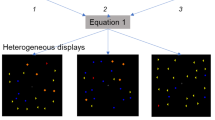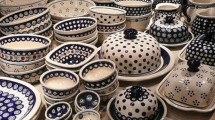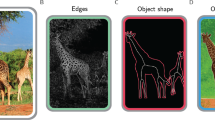Abstract
Objects in the natural world possess different visual attributes, including shape, colour, surface texture and motion. Previous perceptual studies have assumed that the brain analyses the colour of a surface independently of its three-dimensional shape and viewing geometry1,2, although there are neural connections between colour and two-dimensional form processing early in the visual pathway3,4. Here we show that colour perception is strongly influenced by three-dimensional shape perception in a novel, chromatic version of the Mach Card—a concave folded card with one side made of magenta paper and the other of white paper. The light reflected from the magenta paper casts a pinkish glow on the white side. The perceived colour of the white side changes from pale pink to deep magenta when the perceived shape of the card flips from concave to convex. The effect demonstrates that the human visual system incorporates knowledge of mutual illumination—the physics of light reflection between surfaces—at an early stage in colour perception.
This is a preview of subscription content, access via your institution
Access options
Subscribe to this journal
Receive 51 print issues and online access
$199.00 per year
only $3.90 per issue
Buy this article
- Purchase on Springer Link
- Instant access to full article PDF
Prices may be subject to local taxes which are calculated during checkout



Similar content being viewed by others
References
Arend,L. E. & Reeves,A. Simultaneous color constancy. J. Opt. Soc. Am. A 3, 1743–1751 (1986).
Troost,J. M. in Perceptual Constancy—Why Things Look As They Do (eds. Walsh, V. & Kulikowski, J.) (Cambridge University Press, 1998).
Gegenfurtner,K. R., Kiper,D. C. & Fenstemaker,S. B. Processing of color, form and motion in macaque area V2. Vis. Neurosci. 13, 161–172 (1996).
Zeki,S. & Shipp,S. Modular Connections between areas V2 and V4 of macaque monkey visual cortex. Eur. J. Neurosci. 1, 494–506 (1989).
Mach,E. The Analysis of Sensations (Dover, New York, 1886/1959).
Beck,J. Apparent spatial position and the perception of lightness. J. Exp. Psychol. 69, 170–179 (1965).
Gilchrist,A. L. Perceived lightness depends on perceived spatial arrangement. Science 195, 185 (1977).
Gilchrist,A., Delman,S. & Jacobsen,A. The classification and integration of edges as critical to the perception of reflectance and illumination. Percept. Psychophys. 33, 425–436 (1983).
Ramachandran,V. S. Perception of shape from shading. Nature 331, 163–166 (1988).
Knill,D. C. & Kersten,D. Apparent surface curvature affects lightness perception. Nature 351, 228–230 (1991).
Adelson,E. H. Perceptual organization and the judgement of brightness. Science 262, 2042–2044 (1993).
Bloj,M. G. & Hurlbert,A. C. The influence of shape and illuminant position cues on surface lightness perception. Invest. Ophthalmol. Vis. Sci. 40, S981 (1999).
Forsyth,D. & Zisserman,A. Shape from shading in the light of mutual illumination. Image Vision Comput. 8, 42–49 (1990).
Nayar,S. K., Ikeuchi,K. & Kanade,T. Shape from interreflections. Int. J. Comput. Vis. 6, 173–195 (1991).
Funt,B., Drew,M. & Ho,J. Color constancy from mutual reflection. Int. J. Comput. Vis. 6, 5–24 (1991).
Nuberg,N. D., Bongard,M. M. & Nikolaev,P. P. I. On constant perception of colour. Biophysika 16, 285–293 (1971).
Kraft,J. M. & Brainard,D. H. Mechanisms of colour constancy under nearly natural viewing. Proc. Natl Acad. Sci. USA 96, 307–312 (1999).
Bloj,M. G. & Hurlbert,A. C. Does mutual illumination improve human colour constancy? Invest. Ophthalmol. Vis. Sci. 36, S639 (1995).
Knill,D. C. & Richards,W. Perception as Bayesian Inference (Cambridge University Press, 1996).
Freeman,W. T. The generic viewpoint assumption in a framework for visual perception. Nature 368, 542–545 (1994).
Wyszecki,G. & Stiles,W. S. Color Science: Concepts and Methods, Quantitative Data and Formulae (Wiley, New York, 1982).
Efron,B. & Tibshirani,R. An Introduction to the Bootstrap (Chapman & Hall, New York, 1993).
Williams,S. M., McCoy,A. N. & Purves,D. The influence of depicted illumination on brightness. Proc. Natl Acad. Sci., USA 95, 13296–13300 (1998).
Acknowledgements
We thank J. Artigas Verde for use of the spectroradiometer, the late P. Callaghan for construction of the pseudoscope, and A. D. Logvinenko for technical information. The research was supported by the Wellcome Trust (A.C.H. and M.G.B.) and by the National Science Foundation (D.K.). M.G.B. was supported by British Federation of Women Graduates, Ian Karten Charitable Trust, an Overseas Research Student Award and the University of Newcastle. Thanks to A. Rees, M. Ridley and P. Schrater for helpful comments on earlier drafts of the manuscript.
Author information
Authors and Affiliations
Corresponding author
Rights and permissions
About this article
Cite this article
Bloj, M., Kersten, D. & Hurlbert, A. Perception of three-dimensional shape influences colour perception through mutual illumination. Nature 402, 877–879 (1999). https://doi.org/10.1038/47245
Received:
Accepted:
Issue Date:
DOI: https://doi.org/10.1038/47245
This article is cited by
-
Perceiving the representative surface color of real-world materials
Scientific Reports (2023)
-
Colour Calibration of a Head Mounted Display for Colour Vision Research Using Virtual Reality
SN Computer Science (2022)
-
Cues to intention bias action perception toward the most efficient trajectory
Scientific Reports (2019)
-
Do specular highlights and the daylight locus act as cues for estimating illumination color from a single object?
Optical Review (2017)
-
Colour constancy in insects
Journal of Comparative Physiology A (2014)
Comments
By submitting a comment you agree to abide by our Terms and Community Guidelines. If you find something abusive or that does not comply with our terms or guidelines please flag it as inappropriate.



